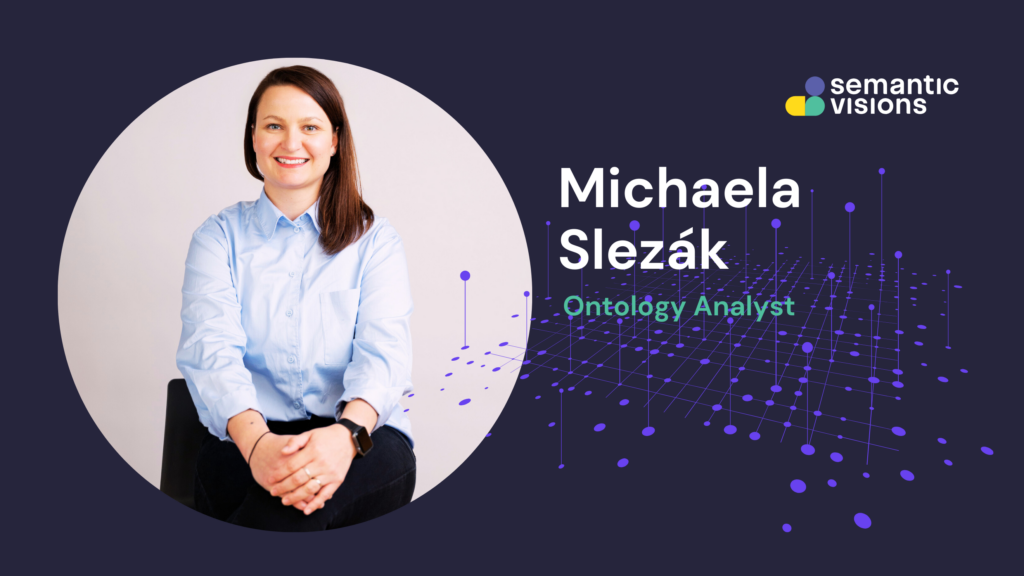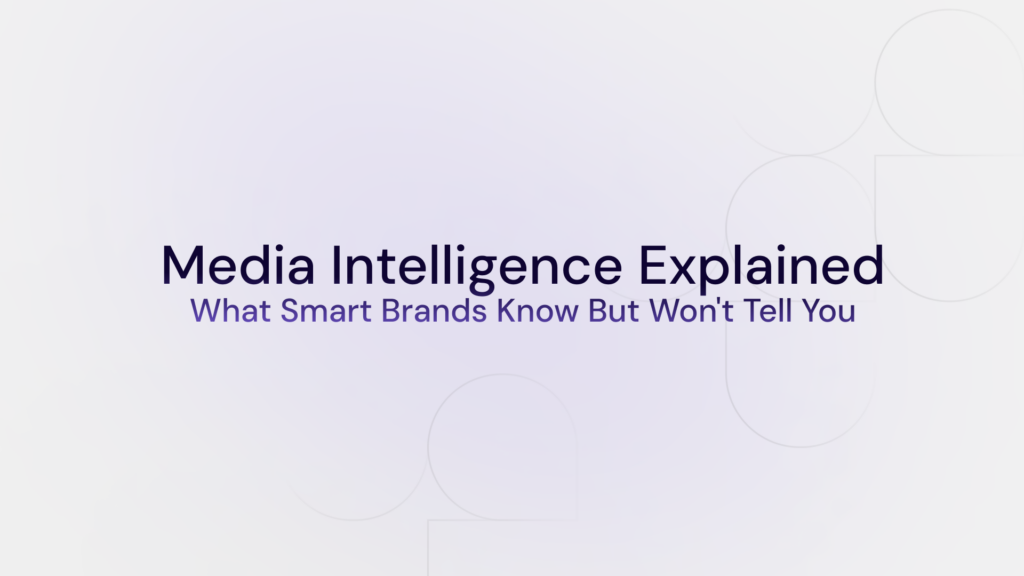9 min read
Michaela Slezák: Bridging Language and Technology to Shape the Future at Semantic Visions

What do you like about your current job at SV?
I love the connection between language and technology, and at Semantic Visions it’s a daily business! And I’m also fascinated by how many different insights we gain from monitoring and analyzing sources, and their potential for both business and responsible decision-making – I like that my work reaches beyond business and has a meaningful, real-life impact!
And, it feels great knowing that my work plays a role in shaping important outcomes and solutions. Just imagine an organization planning its future expansion, a company screening its supply chain, a business evaluating a partner’s ESG credit, or an NGO growing its global operations. This is how our data makes a difference. Amazing, isn’t it?
Sounds like it. But what fascinates you so much about languages? Do you deal with a specific language?
My role isn’t focused on just one language—I’m involved with all of them. What fascinates me most is the diversity of languages we work with, each one bringing its own unique challenges. For instance, Arabic’s morphology is vastly different from Spanish, yet we need to process and understand both to keep our monitoring systems running smoothly. It’s this variety and complexity that keeps me engaged and excited.
What is your language background and what is your linguistic competence?
I was born and raised in the Czech Republic, so Czech is my mother tongue but my academic journey led me to pursue a PhD in English linguistics. I have also spent some time in Barcelona (plus I’m on an almost 900-day streak in Spanish on Duolingo) so I can get around speaking a bit of Spanish. Lastly, I have Icelandic on my language-learning bucket list purely because of its beautiful sound!
Because of this background, I have a good grasp of how different languages function, but I don’t need to know every language we cover at Semantic Visions. We have fantastic tools available, and I can always count on the expertise of our talented language specialists. My role is more supportive, including technical aspects—I’m responsible for the weekly merging and releasing of new taxonomies.
Taxonomies? What should one imagine under a “taxonomy”?
Taxonomy is basically any system that organizes and structures key concepts, their relationships and hierarchies. We use these systems to represent concepts for easier navigation and understanding. In some sense, this categorization of information resembles the way the human brain works as it often organizes facts and information hierarchically, much like a taxonomy. For instance, when learning new concepts, we tend to group related information together, starting from broad categories and then drilling down into more specific details.
But back to the question you asked earlier… Apart from what I’ve already mentioned, the language variety provided by SV enhances the topic coverage and overall cultural sensitivity.
Simply put, with 12 different languages we can easily catch events that can be underreported or overlooked in certain languages or regions and, moreover, the range of languages we operate in allows us to capture specific cultural subtleties that can be lost in translation. This way, we have a truly global reach and we are ready for a global audience!
Was your career path towards data analysis straightforward?
My career path so far has been anything but straightforward! As I said earlier, I had an academic career at my alma mater in my hometown, Ústí nad Labem. My transition to tech started over 10 years ago with a couple of remote data annotation projects in the automotive industry. It was my first taste of how language and tech can come together to solve real-world problems – like developing speech recognition software for under-represented languages such as Czech – and I was hooked. Then, I gradually gained more experience, signed up for a couple programming courses, and the rest is history :-).
In the end, analytics turned out to be a perfect fit for me as it allows me to put on my detail-oriented, spreadsheet loving hat and nitpick in the name of improvement! :))
What is so special about working in the Ontology team?
Working in the Onto team highlights the importance and the crucial value of human work in a climate where everyone expects AI to take over in the near future. We combine the two approaches, and that is our added value. On the one hand, we have a massive processing ability and we apply machine learning methods, and on the other hand, I believe that human input is still (and will be!) necessary to help solve ambiguities that both natural language and different cultural contexts pose (enter 12 different languages and different cultural contexts). In this sense it is invaluable to have “humans in the loop” (and in this case not “some” humans but proper language experts that help us strategically combine their expertise with AI).
What tasks do you work on?
I get to work on very interesting QA tasks – this involves checking the outputs of our technology, making sure that our definitions are applicable across all the languages. I deal with the category hierarchy and preparation of new categories whenever the need surfaces. And in addition, I oversee annotations and cooperate with our ML experts on defining bulletproof annotation guidelines. I strive for consistency!
As the Onto team works with lots of data, there is a direct connection to machine learning (so much that we now have our own ML member – Beatrice :-)). Together, we facilitate entity recognition, relationship extraction, and language understanding. Our language experts and their ontologies help optimize our ML and AI models as well – for instance by enhancing content categorization which is rather extensive!
So, how does your Ontology department fit in with the rest of the company?
Well, in the real world there’s a ton of content online and more and more is being created by the day. The role of our team is to help to “decode” the sheer amount of text data out there. Our systems do that by processing the online content, categorizing it and extracting “the important stuff” relevant to our clients and organizations we serve. And this is where the value of “human input” comes into play. The beauty of any language lies in its ambiguity and context-dependency, a language needs a human mind to decode it. The role of ourselves, experts, is to provide this contextual understanding and to make sure our products are aligned with human values and needs.
Are there specific industries that Semantic Visions delivers for?
Semantic Visions works across industries, and over the years we have developed our proprietary technology that analyzes online content and turns it into structured data. Moreover, we have an extensive database of archived data that goes back 10 years, amounting to 3bn data objects. This trove of data allows for a historic screening of a given business or organization, their performance, management changes or reputational issues, just to name a few. Think of the ESG agenda, supply chain disruptions over time or tracking cyberattacks and cybersecurity. We work across all industries- in manufacturing, consumer goods, technology sector, banking, financial institutions, consulting business.
So, can you explain in simple terms how your system is applied in order to deliver to your clients?
Our AI system automatically connects companies or entities to risk events and analyzes millions of signals that are calculated, based on the relevance for our clients.
Then source analysis performs automated source discovery, classification, ranking, and evaluation. Through NLP, we extract events, entities, topics, sentiment, and themes. Our taxonomies describe the relationships between the so called event types and entities (industries, companies, organizations, commodities, topics, locations, and individuals). And at the end, we deliver structured data for areas such as: risk detection and management,
opportunity detection, alternative data, AML, supply chain risk management, and others. Recently we also launched our own ESG index, a handy tool to monitor ESG performance across industries.
I see. How big a role does the sustainability agenda play in your life, if any at all?
Admittedly, the sustainability agenda does play an important role in my daily life! I’m all about recycling and food waste. As a consumer, I try to be considerate of a number of aspects – be it avoidance of fast fashion (and shopping sprees in general), support for responsible companies and local products and my general reluctance to adopt any of the quickly changing trends.
Working at SV allows me to stay informed about environmental issues as a byproduct of my tasks which is a great plus!
Amazing. Any other benefits you get from working at Semantic Visions?
As I said earlier, besides the fact that my work goes beyond the confines of business and has a real-life impact, I have, thanks to the monitoring we deliver, an overview of various issues such as women’s empowerment, labor disputes, sustainable principles, then disasters and accidents, innovations in pharma but also highs and lows in the tech industry, I could go on…
And, in addition, I learn about things happening around the globe that I otherwise would have no chance of knowing (like the rising price of coffee beans, so now I can brace myself for a more expensive cappuccino at my favorite café.) And being part of an international team is fun and brings a special atmosphere. Thanks to my job, I am simply a citizen of the world.
And something more personal, what do you like doing for fun?
I am not that original in this respect, I’m afraid – generally it is sports, traveling and largely music that make me happy the most! I’m a musical chameleon—I can go from Czech and Slovak rap and trap, to post-hardcore and metal, then vibe with techno, but still find myself chilling to indie folk and country. My playlists are basically musical chaos, and I love it.
Wow! Thanks for sharing so many interesting insights with our readers and best of luck.






